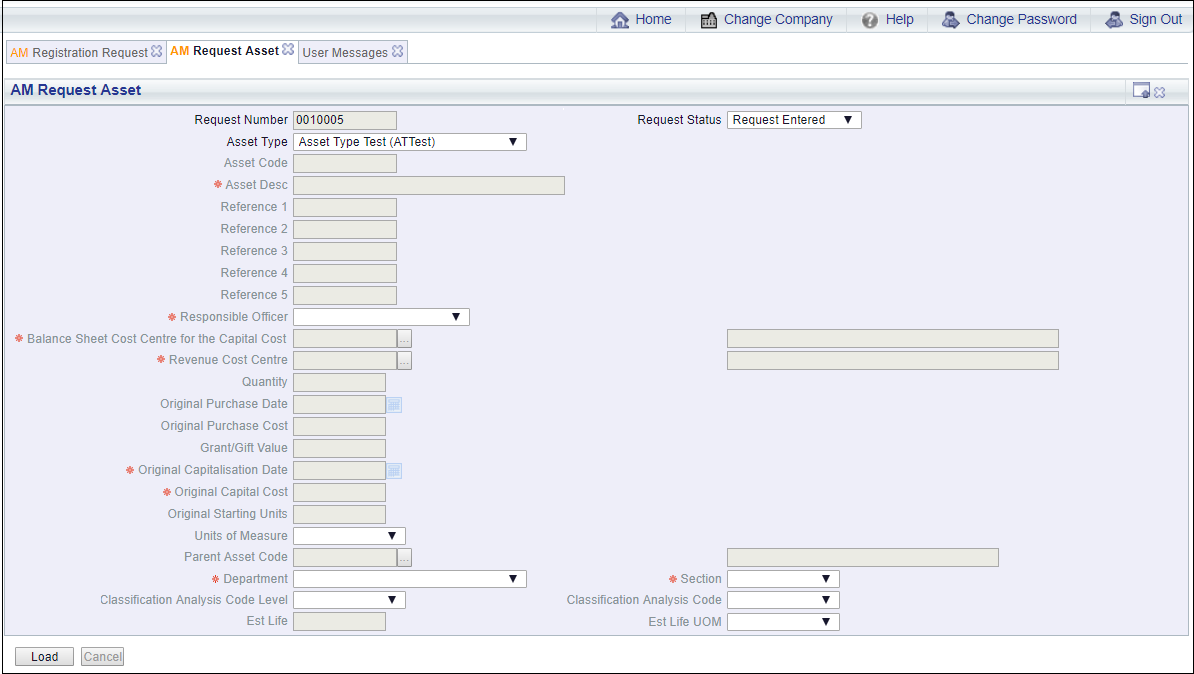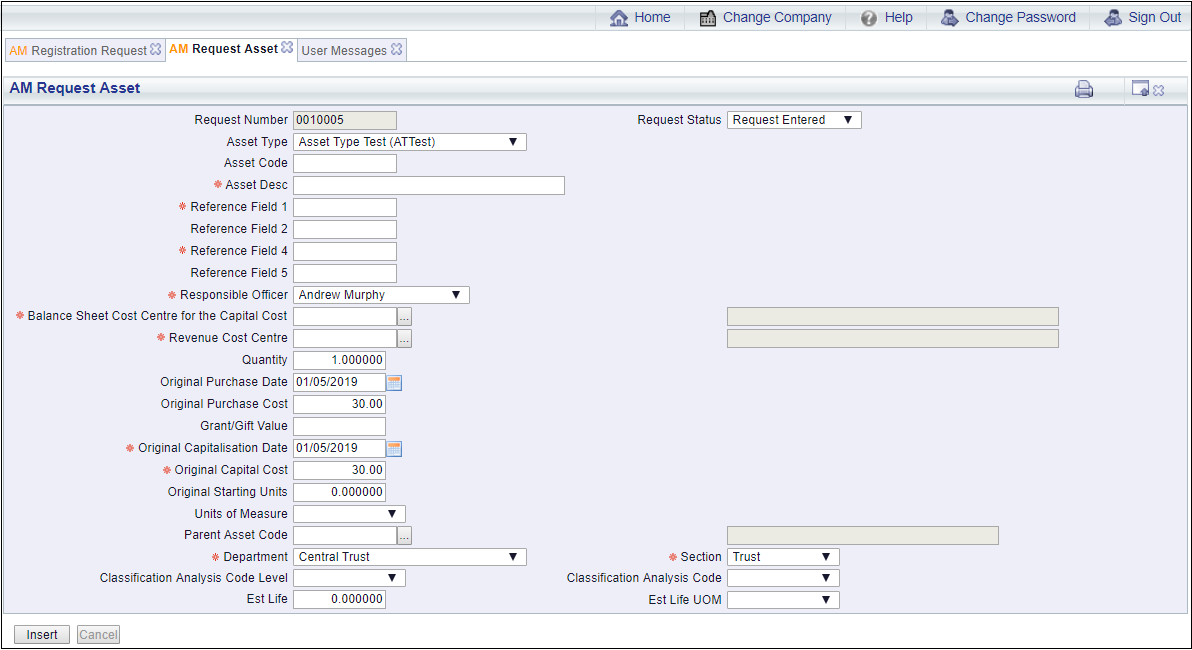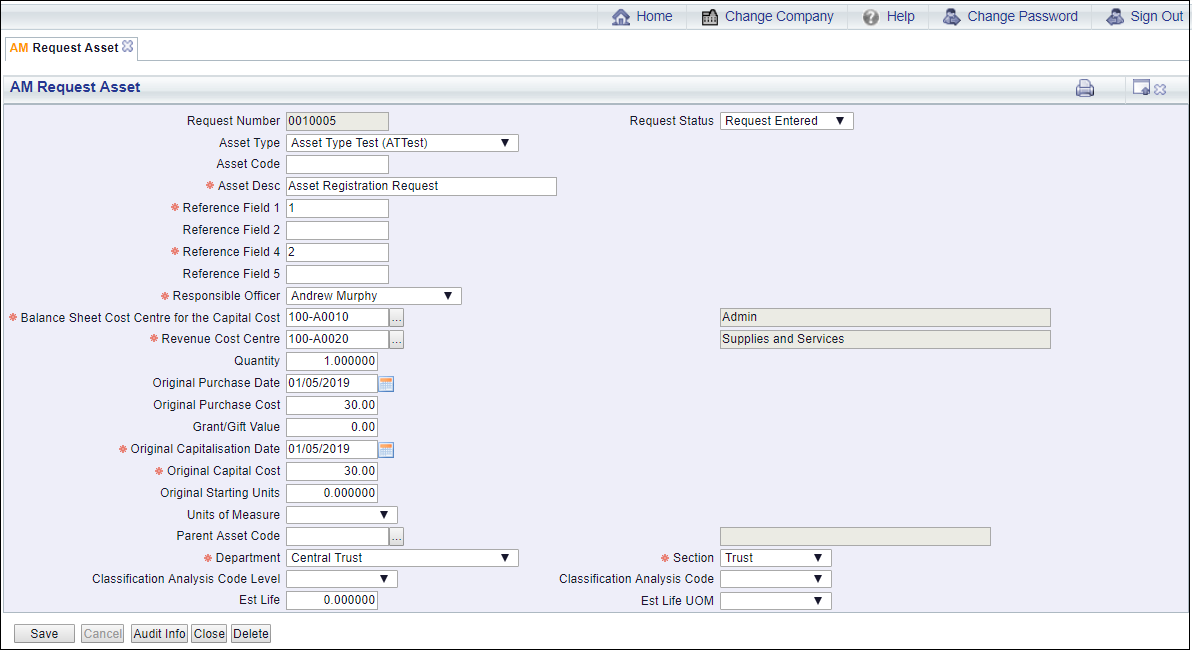The AM Request Asset form allows you to add details for the Asset to the Asset Registration Request. This form can be accessed by clicking  button on the AM Asset Registration form, as detailed in the Amending/Accepting/Rejecting Asset Registration Requests section.
button on the AM Asset Registration form, as detailed in the Amending/Accepting/Rejecting Asset Registration Requests section.
The AM Request Asset form will open:

The only field that you will be able to change on this initial form is the Asset Type field. Where it is blank select an option from this drop-down field. Where an option has already been selected it can be changed as required by selecting a different option from the drop-down list.
Click on the  button:
button:

The fields on this form are further detailed below (mandatory fields are notated with a red asterisk *):
- Request Number: This field will display the reference number for the Asset Registration Request and cannot be amended.
- Request Status: This field will contain the status of the Asset Registration Request and will be set to
 . You will not be able to change this field.
. You will not be able to change this field.
- Asset Type: This field may include the Asset Type of the Asset, which defines the User defined Reference fields displayed between the Asset Description field and the Responsible Officer field and can be changed if required by selecting a different option from the drop-down list. Where the field is blank an option can be selected from the drop-down list.
The Asset Type added will also define certain fields on the Asset Book when it is inserted into the Asset via the AM Asset Maintenance (Insert Book) form, which is further detailed in the Insert Books section. Asset Types are further detailed in the Asset Types section.
- Asset Code: Add the code of the Asset to this field if required. Where this field is left blank a code will be generated for the Asset when the Asset Registration Request has been accepted.
- Description: Add a description for the Asset to this field.
- Responsible Officer: This field will contain the User name of the officer that is responsible for the Asset and will default to the User creating the Asset details and can be changed by selecting a different officer from the options in the drop-down list.
- Balance Sheet Cost Centre for the Capital Cost: Add the relevant General Ledger Cost Centre to this field that will receive the GL postings for the Balance Sheet. Once added you will note that the name of the Cost Centre appears in the adjacent field.
Alternatively the required Cost Centre code can be searched for and selected by clicking on the Find Cost Centre button located to the right of this field,  . This will open the AM Find Balance Sheet Cost Centres for the Capital Cost form where the required Cost Centre can be searched for and once selected will be added to this field. This form is further detailed in the Find Balance Sheet Cost Centre section.
. This will open the AM Find Balance Sheet Cost Centres for the Capital Cost form where the required Cost Centre can be searched for and once selected will be added to this field. This form is further detailed in the Find Balance Sheet Cost Centre section.
You will note that the name of the Cost Centre added will appear in the adjacent field.
- Revenue Cost Centre: Add the relevant General Ledger Cost Centre Code to this field that will receive the GL postings for the Revenue Accounts. Once added you will note that the name of the Cost Centre appears in the adjacent field.
Alternatively the required Cost Centre can be searched for and selected by clicking on the Find Cost Centre button located to the right of this field,  . This will open the AM Find Revenue Cost Centres form where the required Cost Centre can be searched for and once selected will be added to this field. This form is further detailed in the Find Revenue Cost Centre section.
. This will open the AM Find Revenue Cost Centres form where the required Cost Centre can be searched for and once selected will be added to this field. This form is further detailed in the Find Revenue Cost Centre section.
- Quantity: This field can be used where Assets are grouped together, for example where a generic Asset is created for all Personal Computers at a specified location, a number can be added in this field for the number of Personal Computers included in the Asset. Where one is to be disposed, it can be split from the original Asset and then disposed. Splitting Assets is further detailed in the Split section and Disposals are further detailed in the Disposal section.
This field will default to 1 but can be changed if required.
- Original Purchase Date: This field will default to the date in the Transaction Date field on the Asset Registration Request and can be changed if required.
- Original Purchase Cost: Where only one Asset is being created from the Asset Registration Request this field will default to the amount in the Net Amount field on the Asset Registration Request. Otherwise it will revert to zero. The amount in this field can be changed if required.
This will be used as the default amount on the Capital Cost field on the AM Asset Maintenance (Insert Book) form, when an Asset Book is inserted on the new Asset. This form is further detailed in the Insert Books section.
- Grant/Gift Value: This field will be blank but where a grant or gift is associated with the Asset, the value of the grant or gift can be added to this field.
- Original Capitalisation Date: This field will default to the date in the Transaction Date field on the Asset Registration Request and can be changed if required. This will also be used to specify the default date on the Depreciation Start Date field on the AM Asset Maintenance (Insert Book) form, when an Asset Book is inserted on the new Asset. This form is further detailed in the Insert Books section.
- Original Capital Cost: Where only one Asset is being created from the Asset Registration Request this field will default to the amount in the Net Amount field on the Asset Registration Request. Otherwise it will revert to zero. The amount in this field can be changed if required.
This will be used as the default amount on the Capital Cost field on the AM Asset Maintenance (Insert Book) form, when an Asset Book is inserted on the new Asset. This form is further detailed in the Insert Books section.
- Original Starting Units: This field will default to zero and can be used to add the starting number of units for the Asset. Where the Depreciation Method is Units of Use, as defined in the Asset Type added to the Asset Type field, the amount in the Original Starting Units field will be used as the default amount in the Starting Units field on the AM Asset Maintenance (Insert Book) form when an Asset Book is inserted on the new Asset. This form is further detailed in the Insert Books section.
- Units of Measure: This field can be used to record the Units of Measure for the amount added in the Original Starting Units field immediately above. If required select the relevant from the drop-down list.
- Parent: This field can be used to link the Asset to a Parent Asset to show that it belongs to a hierarchy of Assets. If required add the code of the Parent Asset to this field.
Alternatively the required Asset code can be searched for and selected by clicking on the Find Asset button located to the right of this field,  . This will open the AM Find Asset Parents form where the required Asset can be searched for and once selected will be added to this field. This form is further detailed in the Find Asset Parent section.
. This will open the AM Find Asset Parents form where the required Asset can be searched for and once selected will be added to this field. This form is further detailed in the Find Asset Parent section.
Where an Asset is added to the Parent field the description of the Asset will appear in the adjacent field.
- Department: This field will default to the Department in the Department Name field on the Asset Registration Request but can be changed if required.
- Section: This field will default to the Section in the Section Name field on the Asset Registration Request but can be changed if required - the options will be dependant on the option added to the Department field, detailed immediately above.
- Classification Analysis Code Level: Please ignore this field - it is possible to add different levels in the Classification Code of the Asset to include Analysis Codes. The Asset will then be linked to these Analysis Codes via the Classification Code.. If you wish to use this functionality please contact a Civica Consultant.
- Est Life: The estimated life of the Asset can be entered in this field - this will be used as the default amount on the Estimated Life field on the AM Asset Maintenance (Insert Book) form, when an Asset Book is inserted on the new Asset. This form is further detailed in the Insert Books section. This amount will be used in conjunction with the Est Life UOM field detailed immediately below.
- Est Life UOM: Select the time period, e.g. years or months, from this drop down field for the Units of Measure for the amount added in the Est Life field, as detailed immediately above. The option selected will be used as the default option on the Estimated Life (Time Units) field on the AM Asset Maintenance (Insert Book) form, when an Asset Book is inserted on the new Asset. This form is further detailed in the Insert Books section
The following buttons are also available at the bottom of the form:
 : Click on this button to add the Asset details to the Asset Request. Additional buttons will appear at the bottom of the form:
: Click on this button to add the Asset details to the Asset Request. Additional buttons will appear at the bottom of the form:

These are as follows:
 : Click on this button to save any further changes to the fields on the form.
: Click on this button to save any further changes to the fields on the form. : Clicking on this button will open the Audit Info screen, providing audit details of the Asset details. This is further detailed in the Audit Info section.
: Clicking on this button will open the Audit Info screen, providing audit details of the Asset details. This is further detailed in the Audit Info section. : Click on this button to delete the Asset details . A message will be displayed asking for confirmation that the details are to be deleted.
: Click on this button to delete the Asset details . A message will be displayed asking for confirmation that the details are to be deleted.
 : Click on this button to close the AM Request Asset form and you will be directed back to the AM Registration Request form - the Asset details will be added to a Grid at the bottom of the form:
: Click on this button to close the AM Request Asset form and you will be directed back to the AM Registration Request form - the Asset details will be added to a Grid at the bottom of the form:

 button on the AM Asset Registration form, as detailed in the Amending/Accepting/Rejecting Asset Registration Requests section.
button on the AM Asset Registration form, as detailed in the Amending/Accepting/Rejecting Asset Registration Requests section.
![]() button:
button:
 . This will open the AM Find Balance Sheet Cost Centres for the Capital Cost form where the required Cost Centre can be searched for and once selected will be added to this field. This form is further detailed in the Find Balance Sheet Cost Centre section.
. This will open the AM Find Balance Sheet Cost Centres for the Capital Cost form where the required Cost Centre can be searched for and once selected will be added to this field. This form is further detailed in the Find Balance Sheet Cost Centre section. . This will open the AM Find Revenue Cost Centres form where the required Cost Centre can be searched for and once selected will be added to this field. This form is further detailed in the Find Revenue Cost Centre section.
. This will open the AM Find Revenue Cost Centres form where the required Cost Centre can be searched for and once selected will be added to this field. This form is further detailed in the Find Revenue Cost Centre section. . This will open the AM Find Asset Parents form where the required Asset can be searched for and once selected will be added to this field. This form is further detailed in the Find Asset Parent section.
. This will open the AM Find Asset Parents form where the required Asset can be searched for and once selected will be added to this field. This form is further detailed in the Find Asset Parent section.
